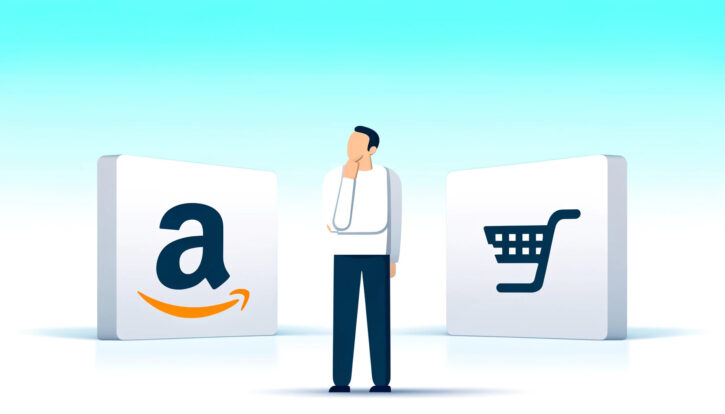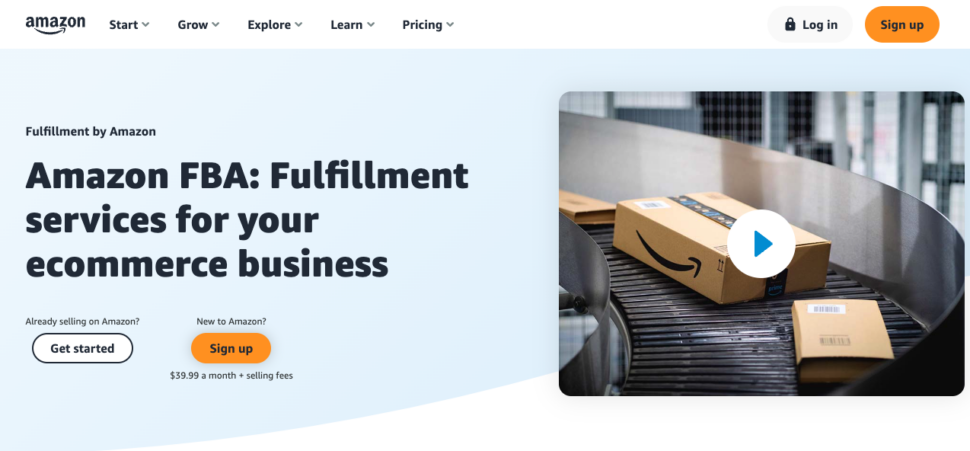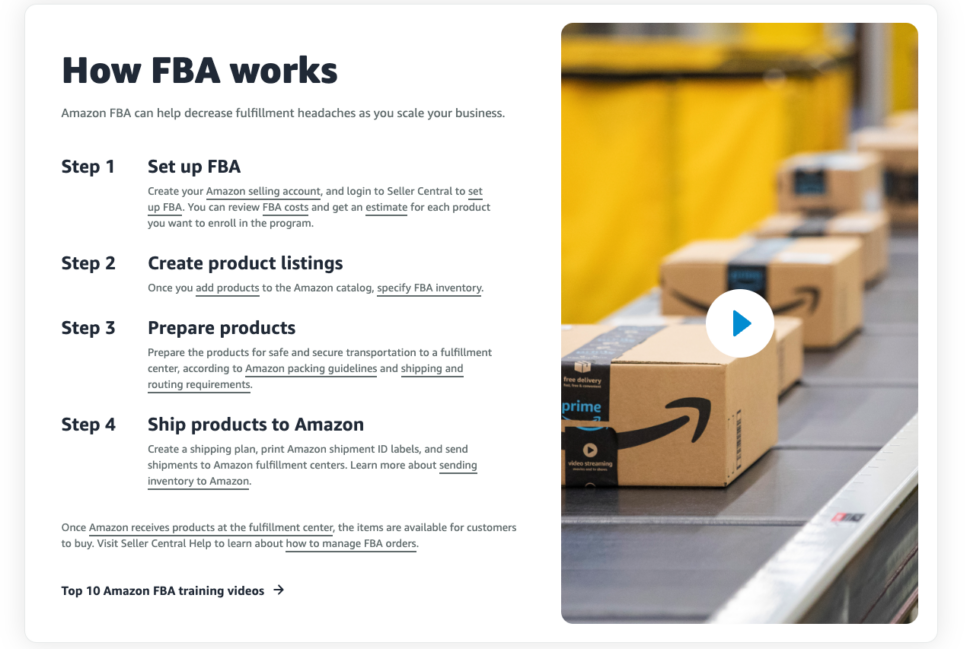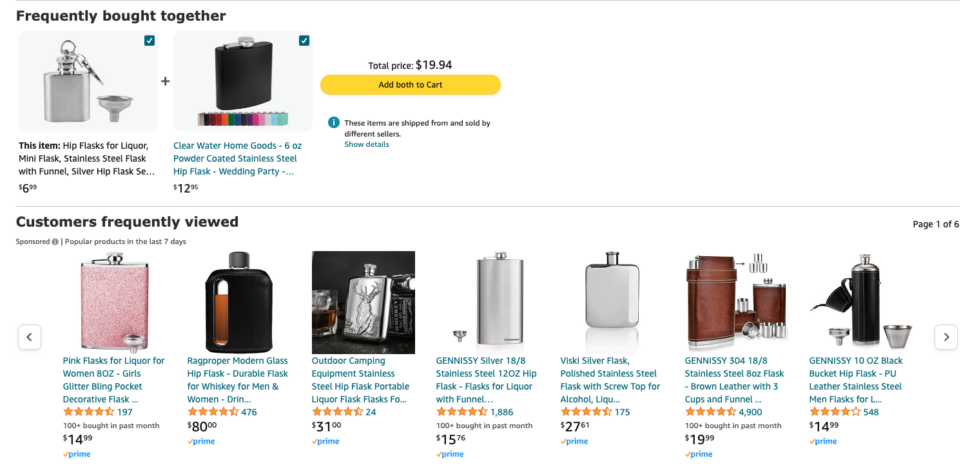Fulfillment by Amazon (FBA) revolutionized e-commerce when it was in its prime – but is Amazon FBA worth it today?
In 2024, there are plenty of other options for new sellers, on and off of the Amazon platform, but FBA still promises a nice passive income on Amazon.
In this article, we’ll take a look at what selling products through FBA is like in 2024. You’ll learn about Amazon policies and all the fees Amazon FBA sellers need to be aware of, as well as evaluate the pros and cons for business owners, entrepreneurs, and third-party sellers. We’ll even share some actionable tips on how to increase traffic to Amazon along the way.
Is Amazon FBA worth it in 2024?
In general, selling products through Amazon FBA is profitable, with some FBA sellers even thriving. However, considering the competition in the Amazon marketplace and the Amazon FBA fees + start up costs, and it’s hard work to get to the top.
Often, the Amazon FBA business is a full-time job, whereas selling on TikTok or other platforms is less of a time investment. On the bright side, if you already have experience getting Amazon sales and know how the platform works, the Amazon FBA program could make your entire operation run more smoothly and efficiently, and even free up some of your time.
The main problem is getting your profit margins to exceed the numerous FBA fees (storage fees, fulfillment fees, and referral fees) on top of the standard costs and your marketing budget. You’ll also have to consider Amazon FBA startup costs if you’re a beginner.
But great risks offer great rewards. If you can navigate the competitive Amazon marketplace, you’ll do more than just keep your business afloat. You’ll have a semi-autonomous e-commerce business model that frees you up to focus on management, marketing, product research, and other high-priority tasks.
Statistics for Amazon FBA sellers
Online business is tough, especially in e-commerce. But as we explained in our guide “Is e-commerce worth it?” you can turn a healthy profit as long as you follow the the recommended marketing strategies, use product research to choose your line carefully, and know a thing or two about sales. This applies to new sellers who want to start either a full-time business or something on the side.
The question is how profitable Amazon FBA can be. Jungle Scout recently compiled some statistics about how much Amazon sellers make, updated for 2024. They include data on Amazon FBA sellers, summarized here:
- 52% of Amazon FBA sellers earn more than $1,000/month, compared to only 40% of all Amazon sellers
- Around 10% of Amazon FBA sellers earn more than $25,000/month
- Around 2% of Amazon FBA sellers earn over $100,000/month
- About a third (31%) of Amazon FBA sellers make less than $500/month
It’s important to note that these statistics reflect a variety of Amazon FBA sellers, both experienced sellers and beginners. Still, the data looks promising even for new sellers, as long as they’re willing to learn all about e-commerce optimization.
How Amazon FBA works
So, backing up a minute – what is Amazon FBA?
The Amazon FBA program is a paid and optional fulfillment service run by Amazon and available to Amazon sellers. Basically, you send your inventory to Amazon fulfillment centers, and they handle the organization, labeling, shipping, and other aspects of the fulfillment process for you.
For inventory management, Amazon FBA sellers need only to worry about getting their products to the Amazon warehouse and refilling stock when it starts running low. From there, the Amazon employees handle the actual order fulfillment, sending out your products where they need to go when you make a sale.
For example, let’s say you’re selling books on Amazon. If you use FBA, you would ship your inventory of books to the Amazon fulfillment center(s) near the locations where most of your deliveries go. Whenever you make a sale, employees at the nearest Amazon warehouse pack the goods and ship them out automatically.
This frees up Amazon sellers to focus on important tasks like marketing, customer support, and product research. Amazon FBA even handles returns processing and refunds to some extent, although sellers will still have to request a refund from Amazon themselves if returned items are lost or damaged.
Convenient, yes, but not free. The Amazon FBA fees for this automation service include storage fees, fulfillment fees, and referral fees, which we’ll discuss more below.
You need an Amazon seller account to sign up for FBA. Fortunately, you can handle a lot of your FBA business directly through Amazon Seller Central.
What do Amazon sellers need to handle when selling through FBA?
Essentially, Amazon FBA handles the storage and order fulfillment aspects of your e-commerce business. Amazon FBA also lends a hand to customer support with returns processing, although it’s recommended that sellers keep a close eye on these. Still, the point of Amazon FBA is to take care of the more monotonous tasks like shipping and logistics so you can spend your time optimizing your products, listings, marketing, and overall strategy.
Specifically, FBA sellers are still in charge of Amazon product research. Finding the right products to sell online is half the battle – you need to identify products that people want and that aren’t readily available already (or that you can offer at a lower price than competitors or with a key differentiator). You also need to find ways to source these products with enough profit margin to make them viable.
Amazon FBA sellers also have to deal with the same issues as all other merchants, such as marketing strategies and nurturing a customer base. These are just common responsibilities for anyone selling products online.
In particular, e-commerce sellers need to optimize their product pages. SEO is a key component of listing optimization – choosing keywords for Amazon can determine whether or not your products appear in relevant search results when shoppers look for them. Amazon SERP optimization isn’t always easy, considering your competitors are likely using many of the same keywords.
Moreover, your product pages need to written to attract attention and garner interest. A little headline testing can help you identify which page titles work for both SEO and shopper interests, as headlines are usually the first thing noticed by shoppers and search algorithms alike. Choosing the right main product image to stand out among the competition is also crucial for drawing clicks and conversions.
On the bright side, doing Amazon A/B testing and rapid consumer research with tools like PickFu can help you build the perfect product page by getting feedback from real Amazon shoppers. You can use PickFu to run polls and surveys comparing multiple product images, descriptions, and more. Within an hour or two, the built-in audience (which you can target to match your ideal customers) will vote for which version they like best and share written comments explaining their choices.
And you can do all of this before you launch your listing, which gives you an advantage from the beginning – as opposed to live A/B testing, where you’ll be automatically showing half of your audience a worse-performing version while you wait for enough data.
You can sign up for PickFu for free and launch your first poll in just a few clicks.
Advantages of FBA in e-commerce
One of the biggest advantages of FBA is the eligibility for Amazon Prime, the premium membership for the Amazon marketplace. Amazon Prime is lucrative for all Amazon sellers, as it offers direct access to shoppers who use Amazon often and already have an intent to buy. In fact, Amazon FBA is the easiest way to earn Amazon Prime eligibility; without FBA, selling on Prime requires getting past extra red tape.
Amazon FBA’s fulfillment options also work well with certain business models like private label or arbitrage (retail or online). Many sellers are working out of their homes, making inventory storage a problem. FBA allows you to store your products at Amazon warehouses instead of your garage.
Perhaps the greatest advantage of FBA is simplifying the supply chain. Instead of tracking simultaneous customer deliveries at the same time, Amazon FBA sellers only have to worry about getting their stock to the Amazon warehouses. FBA ships and monitors all your customer deliveries for you.
Indirectly, this automation let you dedicate more time to marketing strategy, product listing optimization, and product research. You can also manage your own website or online store if you have one.
Additional benefits include lower shipping costs thanks to special deals working directly with Amazon. You’re also free to use external services like Jungle Scout or Helium 10 with Amazon FBA, so it shouldn’t disrupt your preexisting business.
Disadvantages of FBA in e-commerce
The greatest disadvantage is without a doubt the Amazon FBA fees. These extra fees, in an already competitive marketplace, are the main reason more Amazon sellers don’t use FBA.
Amazon FBA sellers must pay the standard membership and referral fees like other Amazon sellers. With FBA, however, you also have to pay fulfillment fees based on product weight, size, and category. You can find a concise rundown of Amazon fulfillment fees here. (Please be aware that Amazon has recently changed their fulfillment fees on April 15, 2024.)
On top of the standard fees, Amazon FBA sellers also have to pay storage fees based on the cubic footage the products take up in the warehouse. The storage fees essentially penalize you for selling large items, regardless of weight; if your products take up a lot of space, such as furniture, you might want to consider other e-commerce fulfillment options.
Aside from the fees, Amazon FBA does not work with all business models, such as dropshipping. In general, dropshipping is ill-advised on Amazon, but with FBA it’s not even possible.
Fulfillment by Amazon (FBA) vs. Fulfillment by Merchant (FBM)
The Amazon FBA program is entirely optional. You can still sell on Amazon using an alternative fulfillment process known as Fulfillment by Merchant, or FBM.
FBM is simply selling products on Amazon and handling the fulfillment process yourself. Not only do you take care of inventory management and storage, but also you manually manage deliveries and shipping.
The advantage of FBM is avoiding those pesky Amazon FBA fees. However, the workload for FBM is much greater than for FBA. You can consider those Amazon FBA fees the cost of handling the supply chain; if you prefer to save money by doing it yourself, you can use FBM instead.
In most cases, FBA is a more efficient option for Amazon sellers, especially considering it gives eligible for selling on Amazon Prime. On the other hand, as mentioned the Amazon FBA fees penalize large and heavy products with extra fees. If your product line deals with big or heavy products, FBM is likely a better choice.
Amazon FBA vs. Temu
One of the latest competitors to Amazon is Temu, a Chinese marketplace specializing in radically low prices. We’ve already discussed Temu vs. Amazon, but there’s a little more to dive into with Temu vs. Amazon FBA.
Temu’s main advantage against Amazon is its low pricing, and that advantage goes even further when up against Amazon FBA. Part of knowing how to sell on Temu requires undercutting prices, making it a good fit for business models like arbitrage. Amazon FBA is almost the opposite; sellers must raise their prices to compensate for the Amazon FBA fees and make adequate profit margins.
Of course, selling on Temu isn’t easy either. Competition is fierce in a marketplace known for its low pricing, so you’ll likely have to use razor-thin profit margins just stay afloat. The pricing on Amazon is competitive as well, but there’s substantial wiggle room that you can’t find on Temu.
If you’re serious about selling on Temu, take a look at our guide to Temu split testing. You’ll see how you can use A/B testing to optimize both your product selection, product pages, and pricing for a Temu audience.
Key takeaways for Amazon seller beginners
If you’re a new seller on Amazon, the choice about whether or not to use FBA can be a tough one. Here are some takeaways to help you decide:
- Amazon FBA is a popular choice for Amazon sellers, and statistically speaking, it is usually worth it.
- A key advantage of Amazon FBA is automating the fulfillment process and supply chain. After the inventory is dropped off at the Amazon warehouse, FBA sellers don’t need to worry about logistics anymore – Amazon handles the storage, labeling, and shipping, as well as other features like customer support, returns processing, and refunds.
- Amazon FBA grants eligibility to selling on Amazon Prime. This is important because Prime members shop more frequently than regular members, and already have an intent to buy. Without Amazon FBA, getting eligibility for Prime involves extra steps.
- Success on Amazon depends largely on product research, marketing strategy, and sales techniques; Amazon FBA can’t help with any of those, so you’ll still need to prepare for hard work.
- The biggest downside is the Amazon FBA fees, which include referral fees, fulfillment fees, and storage fees. These fees penalize large and heavy items, so depending on your product range FBA may not be for you.
If you’re ready to get started with Amazon FBA, keep PickFu in mind to help you optimize your product concepts, designs, packaging, and listings. The platform enables sellers to get instant feedback from real consumers in their target audience – helping you make data-driven decisions and drive more sales. Sign up for free to give it a try.
Amazon FBA business FAQs
Is Amazon FBA worth the FBA fees?
Lots of Amazon FBA sellers turn a healthy profit, regardless of the FBA fees. If you’re good at selling products online and understand e-commerce marketing strategies, Amazon FBA could be a big help by taking care of the fulfillment process for you. However, FBA fees are worse for products that are large and/or heavy, so depending on your product range you may want to look elsewhere.
Can you sell on Amazon Prime with FBA?
Yes, Amazon FBA sellers are eligible for selling on Amazon Prime. In fact, this is a key advantage of FBA; selling on Amazon Prime without FBA requires extra steps, and still no guarantees.
Is product research different for Amazon sellers with FBA?
The products listed on Amazon are a mix between FBA and FBM (Fulfillment By Merchant), so the product research doesn’t really change depending on which one you’re using. However, FBA has advantages like Amazon Prime eligibility, so you may want to consider choosing products specifically for Prime members. Similarly, Amazon FBA sellers should focus on small and lightweight products to minimize Amazon FBA fees.








